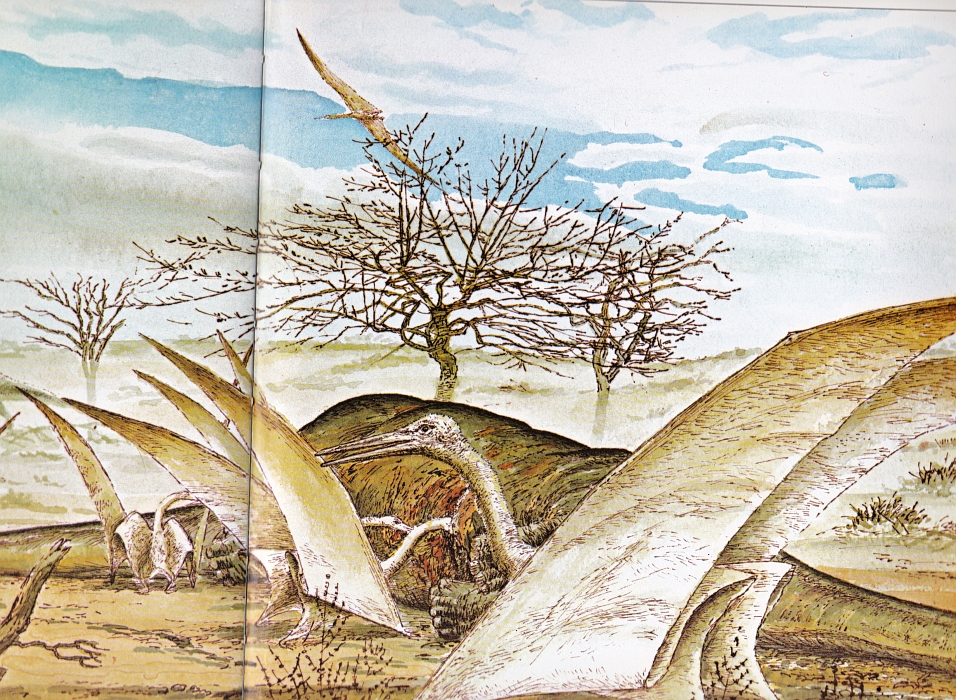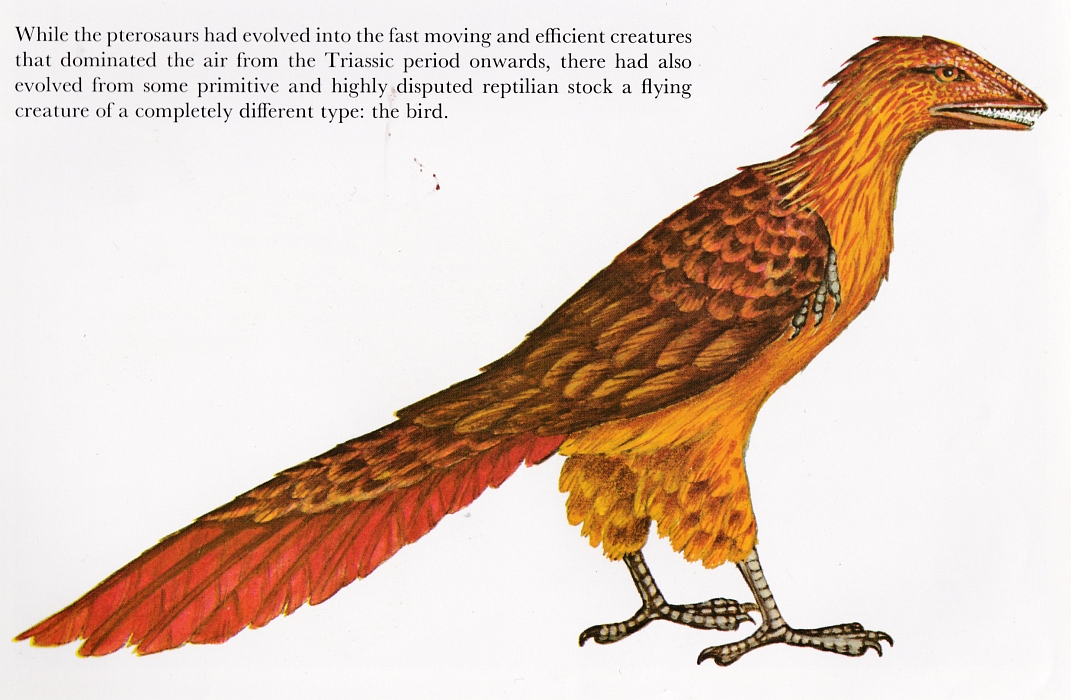Never judge a dinosaur book by its cover. The first edition of Naish and Barrett’s Dinosaurs: How They Lived and Evolved, back in 2016, had an eye-wateringly dreadful example of NHM (London) stock image muck on its cover, but the book itself was excellent, as I noted at the time. While the art on The Day of the Dinosaur‘s dust jacket isn’t bad in itself – it’s the Age of Reptiles mural, for crying out loud – it also does the book a disservice. Fantastic as Zallinger’s work is, it instantly evokes what, at the time (1982, first ed 1978), was becoming a discredited and outdated view of dinosaurs as dim-witted, slothful dullards. Naturally, one takes one look into the dim-bulb eye of Zallinger’s Tyrannosaurus and assumes that Day is going to be yet another lazily cobbled-together 1970s dinosaur book that leans on the defunct science of another era.
But it doesn’t. Far from it!

That said, there is still a lot of very old-school artwork in this book, most of it Neave Parker pieces that will be very familiar to our readers, I’m sure. It’s strange, as John Man makes it clear early on that he is excited by the advances in dinosaur science that had occurred in the decade or so prior to the book’s publication. There’s no haughty dismissal of Dinosaur Renaissance ideas here; none of the scoffing at Ostrom and Bakker’s ideas that would be found in a contemporary book written by one of the palaeontological Old Guard of the time. Certainly, Man doesn’t indulge in any John McLoughlin-style trashing of the “stodgy professors” and their “great fossil lizards” either – both sides are given an airing. Nevertheless, in the book’s introductory chapter, Man says of dinosaurs:
“Slow? Cumbersome? Ill-equipped for survival? No, indeed. Many species were adapted for rapid and sustained action on their hind legs. Even the giants were beautifully engineered to cope with their massive bulk on dry land…The title of this book therefore has two senses. The first refers to the Age of Dinosaurs which ended 65 million years ago…In a second sense, however, the title refers to the current revival of interest in the great beasts. In terms of scientific controversy, today is the Day of the Dinosaur.”
And directly opposite that statement of intent is the following portrait of a handsome beastie.

Sadly, the artist behind this Dilophosaurus piece isn’t credited – the only such instance in the book. (If you have an edition where this oversight is corrected, please let me know.) I’m not convinced that this works anatomically (although the tricky perspective probably doesn’t help in judging that), but other than that, I’m a big fan. This feels like an original attempt at portraying a real animal, rather than a hackneyed take on a well-known monster character. It perhaps helps that the animal wasn’t that well represented in palaeoart at the time. The shading is beautifully done, appearing quite sketchy at first glance, but adding up to create a very tangible, textured animal. It appears to have been drawn as if the animal is facing us, but with its head cocked slightly to the right. Like it’s taking a moment to contemplate us. It’s a wonderfully atypical image of an animal that’s usually depicted as a lunging set of fangs with a crest (when it isn’t a genetically-spliced frilled weirdo).

Further portraits include this one by Petula Stone of Brachiosaurus (Giraffatitan brancai in today’s money), which although beautifully painted, is shrinkwrapped to buggery by today’s standards. Ah, well. The result is at least rather startling to look at and visually arresting, especially when compared with the old-school depictions of sauropods that readers would have been familiar with at the time. The solid yellow eye with slit pupil and protruding teeth look downright ferocious, the nostril looks like a bit of an afterthought, and there are no ears to speak of (or speak into). It does look like a bit of a zombie-saurus. However, the skin folds on the neck and overall speckliness are superbly done. Note also the lack of huge, glaringly obvious scales, which is true to most preserved scaly dinosaur skin. Quite unlike…

…This portrait of Tyrannosaurus by Linda Broad, which sports rather fanciful rectangular and diamond-shaped scales over its gaping maw and copious neck folds. It’s also quite obviously based on Neave Parker’s depiction of the same animal, which is unfortunately also featured here a couple of pages further in. Hence the oddly uniform teeth and vertical neck positioned directly underneath the skull, although Broad has given the animal much larger eyes, for some reason. It’s peculiar to see work like this, alongside Parker’s T. rex, featured in a book that takes care to mention that the animal “probably did not walk upright, but horizontally, its tail acting as a counter-balance to its body”. In fact, this illustration appears opposite a photo of a much more modern-looking model of Tyrannosaurus in a horizontal walking pose, with its (much more accurate) head and neck arranged correctly and its tail held in the air. Thankfully, there are at least some illustrations of Rexy that are a bit more up-to-the-minute…

…Like this one. Double-page illustrations by Richard Bell feature throughout the book, and they all seem to be dominated by the same yellowy-greens and greenish-yellows and browns. As a result, they can become rather bland and samey to look at, and sometimes it’s hard to distinguish individual elements in the scene (more on which shortly). They also all seem to take place in the same landscape, which is largely devoid of vegetation. Still, it’s notable that he always depicts dinosaurs as active animals in a suitably Dino Renaissance fashion, holding their tails proudly in the air and doing more than just standing around like dead-eyed Zallingerian behemoths. In the above image, Rexy might be the same yellowy-brown colour as everything else, but he’s also muscular, actively hunting live prey, and holding his tail parallel to the ground. (Honestly, that’s a big deal.) The hadrosaur looks a bit like an underside view of that Corythosaurus model kit that did the rounds for years (including as a piece of JP merch at one point), especially given its one very flat foot, but I wouldn’t like to speculate. Also noteworthy: Rexy has a reversed hallux, a look he clung onto for years but ditched in the 1980s. Shame, as it was dead handy for getting a grip on his prey (as seen here).

Happily, we’re also treated to Bell’s take on the classic Triceratops v T. rex face-off. Again, all the animals here are depicted with well-defined musculature and more-or-less ‘modern’ postures; there isn’t a tail-dragger in sight. At this point, I should point out that the book and my scanner didn’t really agree. I couldn’t quite get a whole page onto it and, as a result, wasn’t able to stitch two pages together as I sometimes do with large, double-page spreads. As such, I feel duty-bound to point out that Rexy’s fat arse isn’t as dominant in the full piece as it appears here. All the same, the King of the Dinosaurs does look rather stiff and awkward here, like it doesn’t really know what it’s doing. That might be the intention, mind, as it’s facing off against three adult Triceratops, the ceratopsian equivalent of a steroidal pro wrestler. Forward-pointing first toes won’t save you now, Rexy.

While Rexy may look very awkward in Bell’s Tyrannosaurus v Triceratops piece, it’s at least easy to tell what’s going on. That’s not quite the case with his depiction of the Bernissart Iguanodon wandering into their Swampy Ravine of Doom, in which the finer details seem to disappear into a brown-green chaos. There are also quite a few rather retro ‘thumbs up’ depictions of Iguanodon, but as is befitting of this book, they are interspersed with far more modern-looking reconstructions. Especially notable among these is the individual in the middle-right in the above detail, which has a horizontal back and extremely straight tail. Once spotted, it makes for a remarkable contrast with the more Burianesque individuals over to the left. Of course, this is typical of a lot of palaeoart of the era, when pre-Dino Renaissance sensibilities (and artistic touchstones and clichés) collided with some pretty radical scientific developments, dude.

One rather charming example of exactly that is Bell’s spread depicting a herd of Diplodocus crossing a flood plain. The Burian and Knight influences are plain to see, but Bell is careful to show the animals’ tails being held clear of the ground, and that they are all walking over dry land (Man describes their narrow feet in the text). The rearing Diplodocus are obviously based on Knight’s work, but it’s significant that there are two of them. The idea is that this is something that these animals could have habitually done. In the caption, Man notes that this “was quite within their physical capabilities”. Elsewhere, he utilises the well-evidenced arguments of Bakker and others to argue that sauropods were a diverse group of highly successful terrestrial animals, and not the uniformly amphibious beasts of (then-)popular imagination. It’s all suitably forward-thinking.

Part of this involves the inclusion of relatively recent discoveries, and thus the giant pterosaur Quetzalcoatlus is featured. Bell’s reconstruction of the animal is in keeping with the very early toothy nightmare demon visions of the 1970s, albeit without the teeth. Still, it’s all very reminiscent of earlier illustrations stemming from Giovanni Caselli’s in The Evolution and Ecology of the Dinosaurs. The airborne individual is pretty much a straight copy of Caselli’s deliberately vague reconstruction. You might also be wondering why these pterosaurs are inhabiting a creepy, foggy Valley of Death where the trees are all skeletal. That’s because, of course, giant azhdarchid pterosaurs are bloody terrifying. Always. The landscape must bend to their eldritch horror.

And finally…it’s an Archaeopteryx. This illustration features in the same chapter as Quetzalcoatlus, as part of a discussion of how Mesozoic reptiles conquered the land, sea, and air. Linda Broad’s illustration is typical of the time in having rather hoatzin-like characteristics and completely inaccurate hands. Perhaps more notable is that Man weighs up both sides of the raging debate on bird origins, giving plenty of room to Ostrom and his wild ideas on birds being dinosaurs. Interestingly, he quotes Ostrom as believing that the backward-pointing pubis of Archaeopteryx “may have been broken during fossilising,” and that it would have been more saurischian-like in life; I’d love to know the origin of that, as it contradicts what Ostrom surely would have known from the most birdlike dinosaurs. Regardless, I find it fascinating that Man was willing to give the birds-are-dinosaurs idea such an airing at a time when established (and deservedly revered) experts like Alan Charig were still highly dismissive towards it. It just goes to show that any dinosaur book, no matter what first appearances might indicate, is always worth a closer look.







5 Comments
Andreas Johansson
March 15, 2019 at 5:09 pm“holding his tail perpendicular to the ground”
Parallel to the ground, I believe you mean.
That Archy looks quite freaky. I think it’s stolen some demonic essence from the azhdarchids.
Marc Vincent
March 15, 2019 at 5:30 pmYes, that is what I meant. Brain fart. Thanks.
Gary
March 19, 2019 at 4:49 pmI have this delightful book. You would have noticed the model of a horizontal t-rex with its head lumps, for want of a more scientific word, showing.it looks quite fetching but i wonder if its likely?
Martin
March 27, 2019 at 3:41 pmIs this an early work by this John Man?
https://en.wikipedia.org/wiki/John_Man_(author)
Marc Vincent
March 27, 2019 at 3:51 pmAppears to be the same John Man, yes.